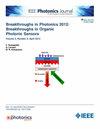Bidirectional SMF-FSO-5G NR Wireless Converged Systems With Polarization Multiplexing Technique to Enhance Transmission Capacity
IF 2.4
4区 工程技术
Q3 ENGINEERING, ELECTRICAL & ELECTRONIC
引用次数: 0
Abstract
This study demonstrates a bidirectional single-mode fiber (SMF)-free-space optical (FSO)-5G new radio (NR) wireless converged system that combines polarization multiplexing and wavelength division multiplexing techniques to enhance transmission capacity. The system achieves an aggregate data rate of 800-Gb/s over a total transmission distance of 41.63-km, comprising 40-km of SMF, a 1.6-km FSO link, and a 27-m 5G NR wireless link. Experimental results indicate excellent transmission performance, with downlink bit error rates (BERs) of 8.13 × 10−5 (x-pol) and 7.76 × 10−5 (y-pol), and uplink BERs of 7.41 × 10−5 (x-pol) and 7.08 × 10−5 (y-pol), which are well below the forward error correction threshold of 3.8 × 10−3. The optimal error vector magnitudes (EVMs) for downlink transmission are 9.14% (x-pol) and 9.39% (y-pol), while the uplink achieves EVMs of 9.6% (x-pol) and 9.78% (y-pol). In contrast, using a unidirectional FSO link in the converged system results in significantly degraded BERs of 1 × 10−3 (x-pol) and 7.59 × 10−4 (y-pol), along with higher EVMs of 11.24% (x-pol) and 11.4% (y-pol) for uplink transmission. These findings emphasize the advantages of bidirectional FSO links in converged systems for enhancing transmission capacity, making them a promising solution for next-generation communication networks.利用偏振复用技术增强传输容量的双向SMF-FSO-5G NR无线融合系统
本研究展示了双向单模光纤(SMF)-自由空间光(FSO)-5G新型无线电(NR)无线融合系统,该系统结合了极化复用和波分复用技术,以增强传输容量。该系统实现了800 gb /s的总数据速率,总传输距离为41.63 km,包括40 km的SMF, 1.6 km的FSO链路和27 m的5G NR无线链路。实验结果表明,该系统具有良好的传输性能,下行误码率(ber)分别为8.13 × 10−5 (x-pol)和7.76 × 10−5 (y-pol),上行误码率分别为7.41 × 10−5 (x-pol)和7.08 × 10−5 (y-pol),远低于前向纠错阈值3.8 × 10−3。下行传输的最优误差矢量幅值分别为9.14% (x-pol)和9.39% (y-pol),上行传输的最优误差矢量幅值分别为9.6% (x-pol)和9.78% (y-pol)。相比之下,在融合系统中使用单向FSO链路会导致ber显著下降,分别为1 × 10−3 (x-pol)和7.59 × 10−4 (y-pol),同时上行传输的evm更高,分别为11.24% (x-pol)和11.4% (y-pol)。这些发现强调了融合系统中双向FSO链路在增强传输容量方面的优势,使其成为下一代通信网络的有前途的解决方案。
本文章由计算机程序翻译,如有差异,请以英文原文为准。
求助全文
约1分钟内获得全文
求助全文
来源期刊

IEEE Photonics Journal
ENGINEERING, ELECTRICAL & ELECTRONIC-OPTICS
CiteScore
4.50
自引率
8.30%
发文量
489
审稿时长
1.4 months
期刊介绍:
Breakthroughs in the generation of light and in its control and utilization have given rise to the field of Photonics, a rapidly expanding area of science and technology with major technological and economic impact. Photonics integrates quantum electronics and optics to accelerate progress in the generation of novel photon sources and in their utilization in emerging applications at the micro and nano scales spanning from the far-infrared/THz to the x-ray region of the electromagnetic spectrum. IEEE Photonics Journal is an online-only journal dedicated to the rapid disclosure of top-quality peer-reviewed research at the forefront of all areas of photonics. Contributions addressing issues ranging from fundamental understanding to emerging technologies and applications are within the scope of the Journal. The Journal includes topics in: Photon sources from far infrared to X-rays, Photonics materials and engineered photonic structures, Integrated optics and optoelectronic, Ultrafast, attosecond, high field and short wavelength photonics, Biophotonics, including DNA photonics, Nanophotonics, Magnetophotonics, Fundamentals of light propagation and interaction; nonlinear effects, Optical data storage, Fiber optics and optical communications devices, systems, and technologies, Micro Opto Electro Mechanical Systems (MOEMS), Microwave photonics, Optical Sensors.
 求助内容:
求助内容: 应助结果提醒方式:
应助结果提醒方式:


